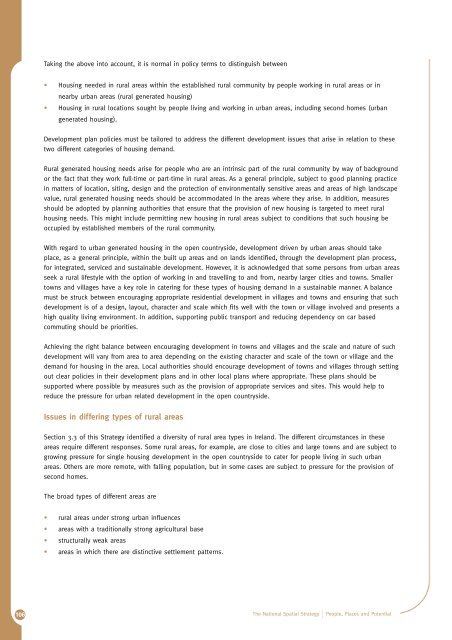National Spatial Strategy For Ireland 2002 - 2020 - Full ... - Kildare.ie
National Spatial Strategy For Ireland 2002 - 2020 - Full ... - Kildare.ie
National Spatial Strategy For Ireland 2002 - 2020 - Full ... - Kildare.ie
You also want an ePaper? Increase the reach of your titles
YUMPU automatically turns print PDFs into web optimized ePapers that Google loves.
106<br />
Taking the above into account, it is normal in policy terms to distinguish between<br />
• Housing needed in rural areas within the established rural community by people working in rural areas or in<br />
nearby urban areas (rural generated housing)<br />
• Housing in rural locations sought by people living and working in urban areas, including second homes (urban<br />
generated housing).<br />
Development plan polic<strong>ie</strong>s must be tailored to address the different development issues that arise in relation to these<br />
two different categor<strong>ie</strong>s of housing demand.<br />
Rural generated housing needs arise for people who are an intrinsic part of the rural community by way of background<br />
or the fact that they work full-time or part-time in rural areas. As a general principle, subject to good planning practice<br />
in matters of location, siting, design and the protection of environmentally sensitive areas and areas of high landscape<br />
value, rural generated housing needs should be accommodated in the areas where they arise. In addition, measures<br />
should be adopted by planning authorit<strong>ie</strong>s that ensure that the provision of new housing is targeted to meet rural<br />
housing needs. This might include permitting new housing in rural areas subject to conditions that such housing be<br />
occup<strong>ie</strong>d by established members of the rural community.<br />
With regard to urban generated housing in the open countryside, development driven by urban areas should take<br />
place, as a general principle, within the built up areas and on lands identif<strong>ie</strong>d, through the development plan process,<br />
for integrated, serviced and sustainable development. However, it is acknowledged that some persons from urban areas<br />
seek a rural lifestyle with the option of working in and travelling to and from, nearby larger cit<strong>ie</strong>s and towns. Smaller<br />
towns and villages have a key role in catering for these types of housing demand in a sustainable manner. A balance<br />
must be struck between encouraging appropriate residential development in villages and towns and ensuring that such<br />
development is of a design, layout, character and scale which fits well with the town or village involved and presents a<br />
high quality living environment. In addition, supporting public transport and reducing dependency on car based<br />
commuting should be priorit<strong>ie</strong>s.<br />
Ach<strong>ie</strong>ving the right balance between encouraging development in towns and villages and the scale and nature of such<br />
development will vary from area to area depending on the existing character and scale of the town or village and the<br />
demand for housing in the area. Local authorit<strong>ie</strong>s should encourage development of towns and villages through setting<br />
out clear polic<strong>ie</strong>s in their development plans and in other local plans where appropriate. These plans should be<br />
supported where possible by measures such as the provision of appropriate services and sites. This would help to<br />
reduce the pressure for urban related development in the open countryside.<br />
Issues in differing types of rural areas<br />
Section 3.3 of this <strong>Strategy</strong> identif<strong>ie</strong>d a diversity of rural area types in <strong>Ireland</strong>. The different circumstances in these<br />
areas require different responses. Some rural areas, for example, are close to cit<strong>ie</strong>s and large towns and are subject to<br />
growing pressure for single housing development in the open countryside to cater for people living in such urban<br />
areas. Others are more remote, with falling population, but in some cases are subject to pressure for the provision of<br />
second homes.<br />
The broad types of different areas are<br />
• rural areas under strong urban influences<br />
• areas with a traditionally strong agricultural base<br />
• structurally weak areas<br />
• areas in which there are distinctive settlement patterns.<br />
The <strong>National</strong> <strong>Spatial</strong> <strong>Strategy</strong> | People, Places and Potential
















